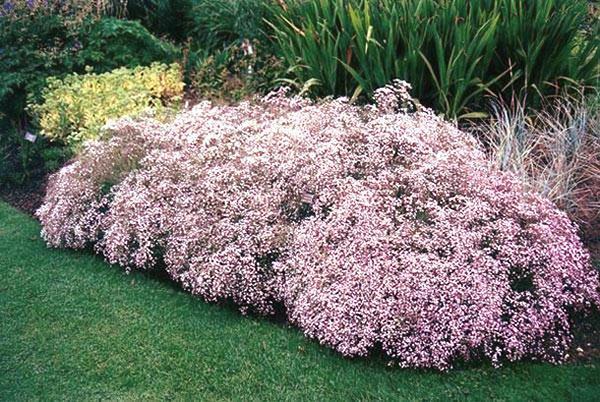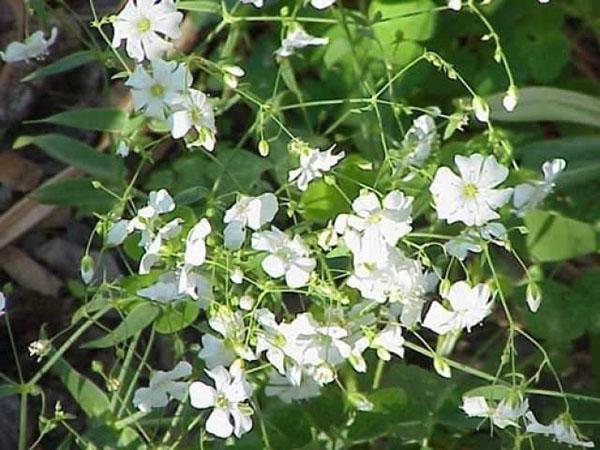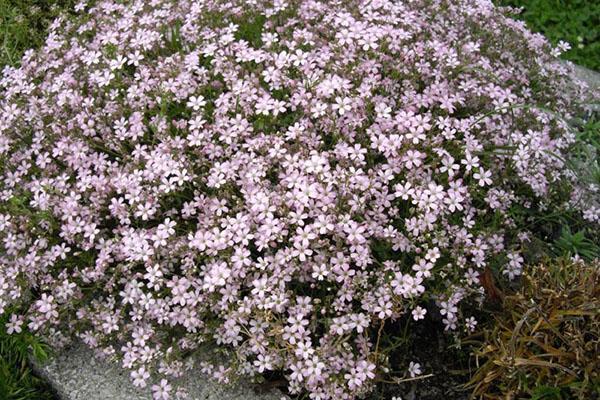We grow gypsophila in our garden
 Gypsophila is a herb that belongs to the Clove family. The name translated from Latin means "loving lime". A flower grows on limestones. The most popular are perennial Gypsophila. The homeland of the plant is the lands of Southern Europe and Asia. The flower is famous for its unusual flowering. Thanks to the thin stems, a dense "cloud" is formed, which is covered with small flowers. Planting and caring for Gypsophila perennial, which is shown in the photo, is not difficult. In order for the plant to be healthy and pleasing with its abundant flowering, you need to know some rules.
Gypsophila is a herb that belongs to the Clove family. The name translated from Latin means "loving lime". A flower grows on limestones. The most popular are perennial Gypsophila. The homeland of the plant is the lands of Southern Europe and Asia. The flower is famous for its unusual flowering. Thanks to the thin stems, a dense "cloud" is formed, which is covered with small flowers. Planting and caring for Gypsophila perennial, which is shown in the photo, is not difficult. In order for the plant to be healthy and pleasing with its abundant flowering, you need to know some rules.
Feature of the plant Gypsophilia

The flower shoots are green. There are practically no leaves on the branches. The main part of the deciduous plates is located in the root part. They are lanceolate with a pointed tip. The leaves can be either dark green or gray. The surface is glossy, smooth.
The first flowers can be seen at the end of June. The buds are collected in paniculate inflorescences, which are placed at the ends of the shoots. The diameter of the flowers ranges from 4 mm to 7 mm. The most popular types of Gypsophila are presented in the photo:

Variety of Gypsophila
There are about 150 types of gypsophila in nature, but only a few are intended for growing in gardens and at home. All plants differ in flowering, shade of petals and shape.
The main types of gypsophila:
- graceful;
- creeping;
- paniculate;
- clear-shaped.
Gypsophila graceful
It is an annual plant type. The adult flower has a small height. With proper care, it can grow from 40 to 50 cm. It grows in the form of a bush. This species is highly branching. The leaves are very small, lanceolate.
The buds are small. When opened, they reach 1 centimeter in diameter. The flowers can be white or light pink. The buds are collected in wide, spreading panicles. Flowers are placed on thin pedicels. Thanks to small buds, the plant takes on an openwork appearance. You can observe the flowering of Gypsophila graceful for a month or a half.
Main varieties:
- Rose - pink buds;

- Elegance - the buds are delicate, white.

This species differs from others in its warmth and light-requiring. Therefore, in order for the plant to develop well and bloom profusely, it is necessary to create optimal conditions for it. Gypsophila graceful is a good addition to such plants like godetia and escholzia. Gypsophila also looks great with marigolds and other brightly colored flowers. Some florists use this type of plant to create bouquets.
All plant species differ in their flowering and bush shape.
Gypsophila creeping
 This species belongs to dwarf plants. It is an unpretentious flower that can grow in almost any area. Because of this, it is often called a mountain plant. A feature of this species is the shoots that spread along the ground.The leaves are narrow-lanceolate, small.
This species belongs to dwarf plants. It is an unpretentious flower that can grow in almost any area. Because of this, it is often called a mountain plant. A feature of this species is the shoots that spread along the ground.The leaves are narrow-lanceolate, small.
Flowering is observed from June to July. It is a frost-hardy species that can grow in one place for up to four years.
The bush is often used to decorate rocky areas and borders.
Main varieties:
- Gypsophila is pink. This is a dwarf plant. The main difference is its rapid growth. In a short time, the flower is able to cover a rather large area. This variety differs in red stems. The maximum height that a plant can reach is 15 cm. Deciduous plates are narrow-lanceolate, green in color. The buds when opened have a pink tone. They grow up to 1 cm in diameter. During the year, the gypsophila pink blooms twice, the first from June to July, and the second in the fall.

- Gypsophila is white. Creeping stems. With proper care, they can quickly form dense bushes. Bare twigs. The leaves are narrow and very small. Plates are dark green. The flowers are white with a pink tone.

Gypsophila paniculata (paniculata)
This type of plant grows up to 120 cm. It is a perennial flower that has an attractive appearance. Differs in knotty stems and strong branching of the bush, especially in the upper part. The deciduous plate, as in other species, is very narrow and small. The flowers grow up to 0.6 cm in diameter. The loose buds can be either snow-white or pink. The plant blooms for 40-45 days. You can watch this miracle from July to August.
Depending on the variety, the flowers are double and simple. All of them are collected in small inflorescences. At the end of flowering, small fruits are formed in the form of boxes. In the middle of each there are up to 1300 seeds. The grains are very small. Their germination capacity lasts for three years. The photo shows the gypsophila paniculata, planting and caring for which are not difficult.
Main varieties:
- Gypsophila Snowflake. The bush is quite dense. Its height reaches 10 cm, and the diameter is -50 cm. This variety is distinguished by a large number of small, double white flowers.

- Gypsophila Rosie Weil. Low-growing variety. Its height ranges from 30 to 35 cm. The plant is unique in its flowers. Only the opened buds have a white tint, but over time they turn light pink.

- Gypsophila Terry. The buds are snow-white, small.

- Gypsophila Pink Star. Flowers are deep pink, double. The bush reaches a height of 60 cm.
- Gypsophila Flamingo. Inflorescences are pink, terry. One of the tall varieties. The size of the bush can reach 120 cm.

- Gypsophila Rosenschleier. This plant spreads over the surface of the earth. Its maximum height can be 40 cm. Flowers are terry, small. The shade of the buds is pale pink. Duration of flowering from 70 to 90 days.

Gypsophila cephalic
 It is a creeping plant that grows up to 10 centimeters tall. Hardwood platinum is egg-shaped. The flowers are small. Their size reaches two centimeters in diameter. The buds can be white or lilac with burgundy veins.
It is a creeping plant that grows up to 10 centimeters tall. Hardwood platinum is egg-shaped. The flowers are small. Their size reaches two centimeters in diameter. The buds can be white or lilac with burgundy veins.
Proper care of gypsophila
 The soil. The plant should be planted in well-lit areas. The soil for the flower should be sandy loam or loamy. It is important that the earth is good for air, water and contains a small amount of lime. To support heavy bushes, it is recommended to make reliable supports in early summer.
The soil. The plant should be planted in well-lit areas. The soil for the flower should be sandy loam or loamy. It is important that the earth is good for air, water and contains a small amount of lime. To support heavy bushes, it is recommended to make reliable supports in early summer.
It is forbidden to plant bushes in lands with groundwater inflow.
Top dressing. If the flower grows in a well-lit area, then fertilization is not necessary. Otherwise, humus should be added to the soil and mineral remedies... When choosing a top dressing, one should take into account that the composition of the preparations does not change the acidity of the soil.  One of the most effective is mullein tincture. Fresh manure is not recommended as it can harm the bush.It is worth feeding in the spring and during the flowering period.
One of the most effective is mullein tincture. Fresh manure is not recommended as it can harm the bush.It is worth feeding in the spring and during the flowering period.
Irrigation. The plant tolerates drought well, so in the open field it practically does not need to be watered. The exception is high air temperatures for several weeks. In this case, it is recommended to pour from 3 to 5 liters of clean water under the root.
Preparing for the winter. Despite the fact that most of the varieties are frost-resistant, additional insulation for the winter will not harm.  In mid-autumn, cut the stems, leaving 10 centimeters above the ground. Then the soil will be required mulch peat. You also need to pour dry leaves on the bush, and put pine branches on top. This is to keep the snow away from the root system.
In mid-autumn, cut the stems, leaving 10 centimeters above the ground. Then the soil will be required mulch peat. You also need to pour dry leaves on the bush, and put pine branches on top. This is to keep the snow away from the root system.
To stimulate the rapid growth of the bush, it is recommended to prune the shoots immediately after flowering.
Reproduction. The growing method for this flower depends on the plant variety. Perennial species can be bred using seeds. The seeds should be sown in open soil before winter.
Perennial species are best bred using seedlings. Grains should be sown in boxes in spring. It is recommended to place the seeds to a depth of 5 cm. In order for the seeds to germinate faster, cover the box with foil or glass and put it in a well-lit place.  Perennial gypsophilia is planted in open ground in the month of May. It is necessary to carry out the procedure only after several leaves appear on the seedlings.
Perennial gypsophilia is planted in open ground in the month of May. It is necessary to carry out the procedure only after several leaves appear on the seedlings.
Seeds should be collected at the end of flowering. The boxes should be cut a little greenish and dried at home in a well-ventilated area. It is recommended to store the seeds in paper bags.
Pests. Gypsophila suffers from fungal diseases quite often. They are capable of causing wet rot, white mold. Also, insects and parasites often affect the flower. With improper care, leaves and stems can become brownish. To get rid of these problems, you should use fungicides. They can be used both for spraying a flower and for watering.
In order for the plant to please for a long time with its appearance and flowering, it is worth adhering to all the rules of care. The correct selection of soil, watering and preparation for the winter will help protect the bushes from death and rotting of the root system.
Growing perennial gypsophila - video